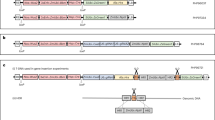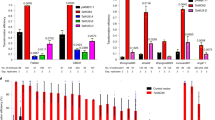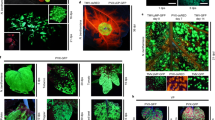Abstract
The graminaceous monocots, including the economically important cereals, seem to be refractory to infection by Agrobacterium tumefaciens1, a natural gene transfer system that has been successfully exploited for transferring foreign genes into higher plants2–4. Therefore, direct transfer techniques that are potentially applicable to all plant species have been developed using a few dicot5–8 and monocot8–10 species as model systems. One of these techniques, electroporation, uses electrical pulses of high field strength to permeabilize cell membranes11 reversibly so as to facilitate the transfer of DNA into cells8,12,13. Electroporation-mediated gene transfer has resulted in stably transformed animal cells12,13 and transient gene expression in monocot and dicot plant cells8. Here we report that electroporation-mediated DNA transfer of a chimaeric gene encoding neomycin phosphotransferase results in stably transformed maize cells that are resistant to kanamycin.
This is a preview of subscription content, access via your institution
Access options
Subscribe to this journal
Receive 51 print issues and online access
$199.00 per year
only $3.90 per issue
Buy this article
- Purchase on Springer Link
- Instant access to full article PDF
Prices may be subject to local taxes which are calculated during checkout
Similar content being viewed by others
References
De Cleene, M. & De Ley, J. Bot. Rev. 42, 389–466 (1976).
Caplan, A. et al. Science 222, 815–821 (1983).
Fraley, R. T. et al. Proc. natn. Acad. Sci. U.S.A. 80, 4803–4807 (1983).
Zambryski, P., Herrera-Estrella, L., De Block, M., Van Montagu, M. & Schell, J. in Genetic Engineering Vol 6 (eds Hollaender, A. & Setlow, J.) 253–278 (Plenum, New York, 1984).
Krens, F. H., Molendijk, L., Wullems, G. J. & Schilperoort, R. A. Nature 296, 72–74 (1982).
Hain, R. et al. Molec. gen. Genet. 199, 161–168 (1985).
Paszkowski, J. et al. EMBO J. 3, 2717–2722 (1984).
Fromm, M., Taylor, L. P. & Walbot, V. Proc. natn. Acad. Sci. U.S.A. 82, 5824–5828 (1985).
Lörz, H., Baker, B. & Schell, J. Molec. gen. Genet. 199, 178–182 (1985).
Potrykus, I. et al. Molec. gen. Genet. 199, 183–188 (1985).
Zimmerman, U. & Vienken, J. J. Membrane Biol. 67, 165–182 (1982).
Potter, J., Weir, L. & Leder, P. Proc. natn. Acad. Sci. U.S.A. 81, 7161–7165 (1984).
Neumann, E., Schaefer-Ridder, M., Wang, Y. & Hofschneider, P.H. EMBO J. 1, 841–845 (1982).
Beck, E., Ludwig, G., Auerswald, E. A., Reiss, B. & Schaller, H. Gene 19, 327–336 (1982).
Southern, P. J. & Berg, P. J. molec. appl. Genet. 1, 327–341 (1982).
Herrera-Estrella, L. et al. EMBO J. 2, 987–995 (1983).
Bevan, M. W., Flavell, R. B. & Chilton, M.-D. Nature 304, 184–187 (1983).
Hohn, T., Richards, K. & Lebeurier, G. Curr. Topics Microbiol. Immun. 96, 193–236 (1982).
Bevan, M., Barnes, W. M. & Chilton, M.-D. Nucleic Acids Res. 11, 369–385 (1983).
Sheridan, W. F. J. Cell Biol. 67, 396a (1975).
Chourey, P. S. & Zurawski, D. B. Theor. appl. Genet. 59, 341–344 (1981).
Murashige, T. & Skoog, F. Physiol. Pl. 15, 473–497 (1962).
Reiss, B., Sprengel, R., Will, H. & Schaller, H. Gene 30, 211–218 (1984).
Schreier, P. H., Seftor, E. A., Schell, J. & Bohnert, H. J. EMBO J. 4, 25–32 (1985).
Southern, E. M. J. molec. Biol. 98, 503–517 (1975).
Feinberg, A. P. & Vogelstein, B. Analyt. Biochem. 132, 6–13 (1983).
Federoff, N. V., Furtek, D. B. & Nelson, O. E. Proc. natn. Acad. Sci. U.S.A. 81, 3825–3829 (1984).
Freeling, M., Cheng, D., S.-K. & Alleman, M. Devl. Genet. 3, 179–196 (1982).
Hooykass-Van Slogteren, G. M. S., Hooykaas, P. J. J. & Schilperoort, R. A. Nature 311, 763–764 (1984).
Hernalsteens, J.-P., Thia-Toony, L., Schell, J. & Montagu, M. EMBO J. 3, 3039–3041 (1984).
Vieira, J. & Messing, J. Gene 19, 259–268 (1982).
Gardner, R. C. et al. Nucleic Acids Res. 9, 2871–2887 (1981).
Rivin, C. J., Cullis, C. A. & Walbot, V. Genetics (in the press).
Shillito, R. D., Saul, M. W., Paszkowski, J., Müller, M. & Potrykus, I. Bio/Technology 3, 1099–1103 (1985).
Author information
Authors and Affiliations
Rights and permissions
About this article
Cite this article
Fromm, M., Taylor, L. & Walbot, V. Stable transformation of maize after gene transfer by electroporation. Nature 319, 791–793 (1986). https://doi.org/10.1038/319791a0
Received:
Accepted:
Issue Date:
DOI: https://doi.org/10.1038/319791a0
This article is cited by
-
Magnetofection approach for the transformation of okra using green iron nanoparticles
Scientific Reports (2022)
-
LaCl3 treatment improves Agrobacterium-mediated immature embryo genetic transformation frequency of maize
Plant Cell Reports (2022)
-
Maize transformation: history, progress, and perspectives
Molecular Breeding (2021)
-
Comparison of efficiency and time to regeneration of Agrobacterium-mediated transformation methods in Medicago truncatula
Plant Methods (2019)
Comments
By submitting a comment you agree to abide by our Terms and Community Guidelines. If you find something abusive or that does not comply with our terms or guidelines please flag it as inappropriate.



